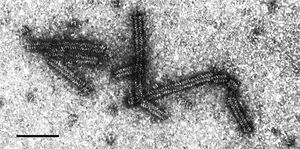Varicosavirus: Difference between revisions
No edit summary |
|||
| (4 intermediate revisions by the same user not shown) | |||
| Line 1: | Line 1: | ||
{{Uncurated}} | {{Uncurated}} | ||
[[Image: | [[Image:Varicosavirus.jpg|thumb|300px|right|Legend. Image credit: Science Direct.]] | ||
==Classification== | ==Classification== | ||
| Line 24: | Line 24: | ||
==Cell Structure, Metabolism and Life Cycle== | ==Cell Structure, Metabolism and Life Cycle== | ||
The cell structure of ''Varicosavirus'' is rod-shaped particles that do not contain a cell envelope, in which they are very fragile. The virus is transmitted via ''Olpedium spp.'', a soil-borne fungus that can move into plant veins from the roots. It negatively impacts the plants it infects. | The cell structure of ''Varicosavirus'' is rod-shaped particles that do not contain a cell envelope, in which they are very fragile. The virus is transmitted via ''Olpedium spp.'', a soil-borne fungus that can move into plant veins from the roots. It infects cells through penetration by effraction into the cytoplasm, performs transcription and replication, then when enough capped m-RNA's are produced they infect neighboring cells. It negatively impacts the plants it infects. | ||
==Ecology and Pathogenesis== | ==Ecology and Pathogenesis== | ||
Latest revision as of 20:56, 12 December 2022
Classification
Viruses; Riboviria; Orthonavirae; Negarnaviricota; Haploviricotina; Monjiviricetes; Mononegavirales; Rhabdoviridae; Betarhabdovirinae
Species
|
NCBI: [1] |
Varicosavirus
Description and Significance
Varicosavirus is a nonenveloped, rod-shaped virus with helix symmetry. It infects veins in lettuce leaves and is associated with causing big-vein disease in field-grown lettuce. The type species and only member of the genus is Lettuce big-vein associated virus (LBVaV).
Transmission of the virus is through moist soil via zoospores from an obligate parasitic soil-borne fungus. LBVaV causes deformities in affected leaves that make them unmarketable.
Genome Structure
Varicosavirus is classified by its 18 nm diameter rods, single-strand RNA, and its two-segmented linear negative sense genome. The first segment, RNA1, has around 7000 nucleotides and the second segment, RNA2, has around 6500 nucleotides. RNA1 encodes for an L protein, which is extremely similar to L polymerases in plant rhabdoviruses. Whereas RNA2 encodes for CP, N protein,and the other genes’ functions are unknown. The main feature of Varicosavirus' genome is that it's segmented, whereas other viruses that have similar functions are not.
Cell Structure, Metabolism and Life Cycle
The cell structure of Varicosavirus is rod-shaped particles that do not contain a cell envelope, in which they are very fragile. The virus is transmitted via Olpedium spp., a soil-borne fungus that can move into plant veins from the roots. It infects cells through penetration by effraction into the cytoplasm, performs transcription and replication, then when enough capped m-RNA's are produced they infect neighboring cells. It negatively impacts the plants it infects.
Ecology and Pathogenesis
This virus causes big-vein disease in lettuce leaves and is transmitted using obligate parasitic soil-borne fungi. The exact fungus is Olpedium spp., but information on the fungus is being evaluated. It favors cool temperatures throughout Europe, Asia, North America, and South America in moist soil. Varicosavirus affects lettuce leaf veins as it causes the leaf to enlarge leading to a more translucent appearance, and drier, more brittle textures. This in turn causes the lettuce to be unmarketable, and it is difficult to rid the soil of the virus and its obligate parasitic fungus.
References
“Varicosavirus”. Encyclopedia of Virology. 2008. Volume 3. p. 263-268. https://www.sciencedirect.com/science/article/pii/B978012374410400649X Sasaya, T.
Kormelink, R., Garcia, M.L., Goodin, M., Sasaya, T., Haenni, A. “Negative-strand RNA viruses: The plant-infecting counterparts”. Virus Research. 2011. Volume 162. Issues 1-2. p. 184-202. https://doi.org/10.1016/j.virusres.2011.09.028
Sasaya, T., Ishikowa, K., Koganezawa, H. “The Nucleotide Sequence of RNA1 of Lettuce big-vein virus, Genus Varicosavirus, Reveals its Relation to Nonsegmented Negative-Strand RNA Viruses”. Virology. 2002. Volume 297. Issue 2. p. 289-297. https://doi.org/10.1006/viro.2002.1420
“Genus- Varicosavirus”. Virus Taxonomy. Ninth Report of the International Committee on Taxonomy of Viruses. 2012. p. 777-781. https://doi.org/10.1016/B978-0-12-384684-6.00065-3
“Varicosavirus”. ViralZone. https://viralzone.expasy.org/503
Bejerman, N., Dietzgen, R. G., Debat, H. “Unlocking the hidden genetic diversity of varicosaviruses, the neglected plant rhabdoviruses”. 2022. BioRxiv. doi: https://doi.org/10.1101/2022.09.19.508500
Author
Page authored by Shelby Kennedy, student of Prof. Bradley Tolar at UNC Wilmington.

